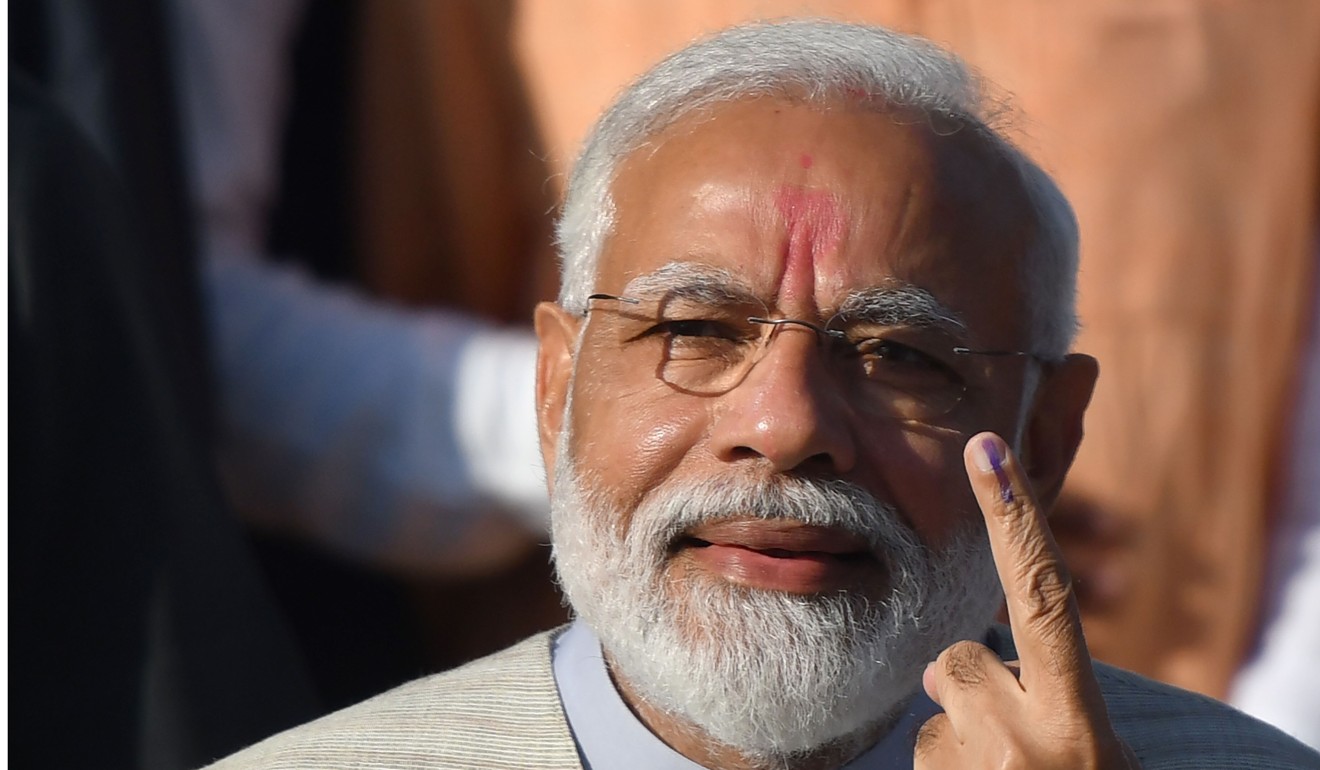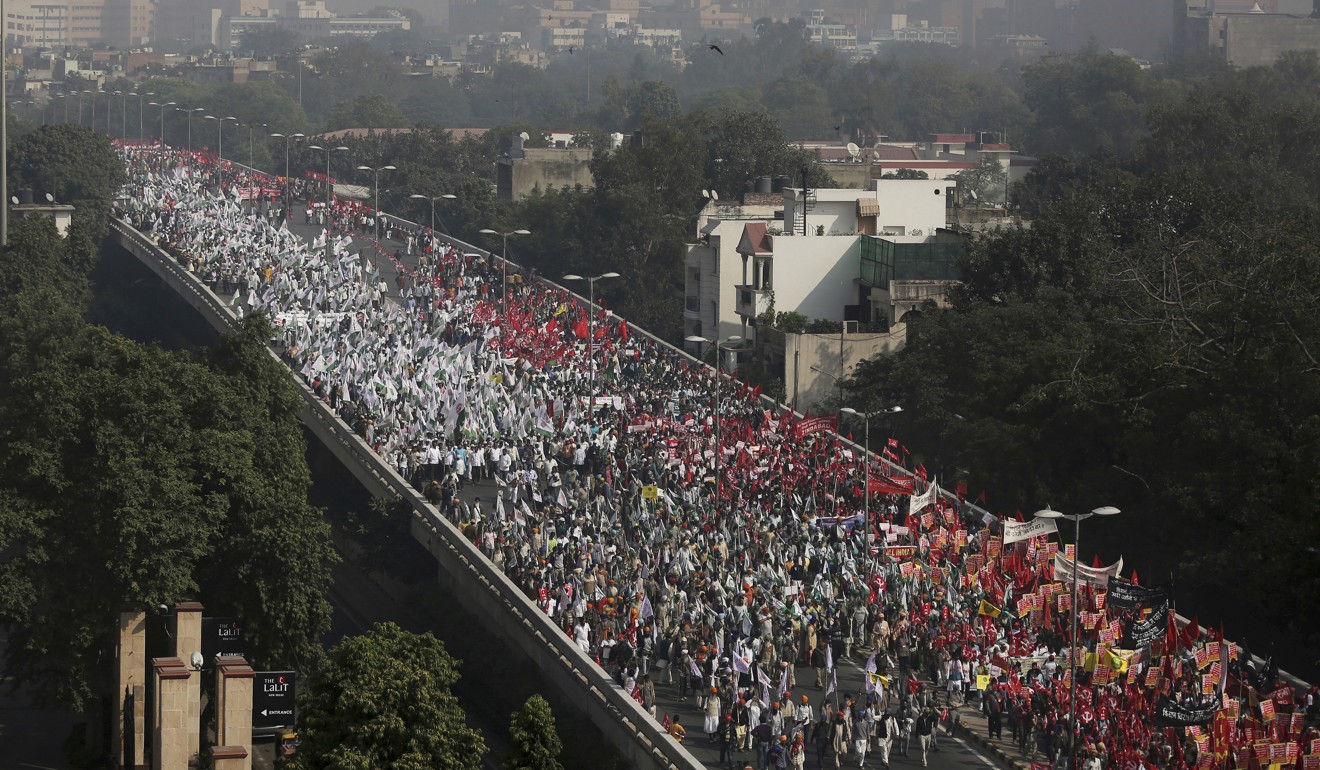- The BJP’s Narendra Modi swept to power on a wave of optimism and a catchy slogan.
- Five years on, an economic slowdown, agrarian distress and rising intolerance have soured the mood
India has been holding its general elections in stages since April 11. The seventh and final phase will take place on Sunday.
The primary contest is for the 543 seats in India’s lower house of parliament, the Lok Sabha.
This is one of the largest democratic exercises in the world, with 900 million voters deciding on a new central government for the 1.3 billion-strong South Asian giant. The results are expected on Thursday.

Indian Prime Minister Narendra Modi shows his ink-marked finger after casting his vote. Photo: AFP
WHAT IS AT STAKE?
Prime Minister Narendra Modi
of the Hindu nationalist Bharatiya Janata Party (BJP) is running for a second term.A former chief minister of Gujarat, he came to power in 2014 with the simple but powerful slogan “ache din aayega” (good days will come).
This resonated with voters – especially in the impoverished northern regions – who were angry at the previous administration of the Congress party that had been dogged by scandal.
BJP may need the allies Modi drove away
As a result, Modi swept to power: the BJP-led National Democratic Alliance coalition won 336 of the Lok Sabha’s 543 seats. The BJP itself won 282 seats – the first time since 1989 that one of India’s political parties had won an outright majority.The other main national political party is Congress, led by Rahul Gandhi, grandson of former prime minister Indira Gandhi. This grand old party of India has been progressively weakening across the country and now stands as only one of the many opposition parties, jockeying for power against resurgent regional players. In 2014, Congress did not even win enough seats to be chosen as the official opposition and was almost eclipsed by the AIADMK, a regional party from Tamil Nadu.
SO MODI’S A SHOO-IN?
Not exactly. Modi’s re-election prospects have arguably been dimmed by the triple threat of an economic slowdown, agrarian distress and concerns about rising intolerance and violence against minorities.
His promise in 2014 to create 10 million new jobs a year for India’s burgeoning youth population has not been fulfilled. Moreover, a recent study by the Centre for Monitoring Indian Economy argued that 11 million jobs were lost last year alone.

Indian farmers protest in New Delhi in November – their plight has become a major electoral issue. Photo: AP
A leaked government survey allegedly showed the unemployment rate to be higher than at any time in the past 45 years. These economic doldrums have largely been blamed on the new Goods and Services Tax imposed by the government and 2016’s botched demonetisation exercise, which took 86.5 per cent of India’s currency out of circulation.
The plight of India’s farmers has also become a major electoral issue. Stagnant grain prices, erratic weather and unresolved systemic problems have led to an alarming number of farmer suicides in a country where more than 50 per cent of the population is employed in agriculture. In 2017, the central government told the Supreme Court that 12,000 farmers had committed suicide every year since 2013.
The BJP’s use of Hindu nationalist rhetoric, meanwhile, has always been controversial. Its leaders, like the monk-turned-Uttar Pradesh chief minister Yogi Adityanath, have been accused of using anti-Muslim rhetoric.
BATTLEGROUND STATES
The outcome of India’s elections often depends on political calculations and issues at the state level. India’s 29 states are highly diverse, both linguistically and ethnically.
Five of these states – Uttar Pradesh, Bihar, Maharashtra, West Bengal and Tamil Nadu – each send more than 40 MPs to the Lok Sabha, meaning that winning them is essential for either side.
The biggest prize among them is Uttar Pradesh, which is one of India’s largest states and has 80 MPs.
In 2014, the BJP was largely able to win nationally because it made huge gains in the massive northern state, taking 71 of the seats that were up for grabs.
Communism in India: dead or just waiting for young saviours?
This time, however, two major local players – the Samajwadi Party (SP) and the Bahujan Samaj Party (BSP) – are challenging the BJP. Both the SP and BSP – which have formed an alliance – are strong with the crucial Yadav and Dalit (formerly known as untouchable) castes in the state.While both the SP and BSP won more than 40 per cent of the popular vote in Uttar Pradesh in the last elections, the SP won only five seats because of India’s first-past-the-post electoral system and its lack of an alliance. This time, some pundits expect the SP-BSP alliance to win at least half of the 80 seats on offer, if not more.
The BJP’s prospects are also being put to the test in the country’s economically dynamic south, where powerful regional parties are challenging its grip on power.
In the states of Andhra Pradesh and Telangana, the regional YSR Congress Party and the Telangana Rashtriya Samithi are expected to sweep the polls. Both have openly said that they prefer a third option for government that does not involve either the BJP or Congress.
In India’s southernmost state and its automotive hub, Tamil Nadu, the socialist, Tamil-nationalist Dravida Munnetra Kazhagam seems to be on the cusp of major gains because of anger at both the BJP central government and its local allies, the AIADMK.
The BJP is also at risk of shedding seats in the central and western states of Madhya Pradesh, Chhattisgarh and Rajasthan, where Congress made gains during recent state elections.
However, Modi’s party is expected to make nominal gains in eastern India, in states such as Orissa, West Bengal and the seven states that make up the country’s northeast.
A major concern in those areas has been allegations of illegal migration from Bangladesh, and the BJP is running a racially charged campaign – playing up local fears of Muslim refugees – to capitalise on this.
WHAT WILL ALL THIS MEAN?
Assuming the BJP loses ground to regional parties, and the Congress retains its meagre base, India might find itself with a virtually hung parliament.
For instance, the BJP and its National Democratic Alliance coalition might be the largest bloc in the Lok Sabha, but still fall short of a majority.
Exploiting Islamophobia: an election-winning tool in India
Regional parties have also been displaying unprecedented acts of solidarity, such as joint rallies featuring all the leaders of large local opposition parties, encouraging the possibility of a non-Congress, non-BJP “third-front” government.So, while the results are far from certain, 2019 might well herald a return to form and the politics India knows best: the proliferation of regional power brokers and complex coalition governments.